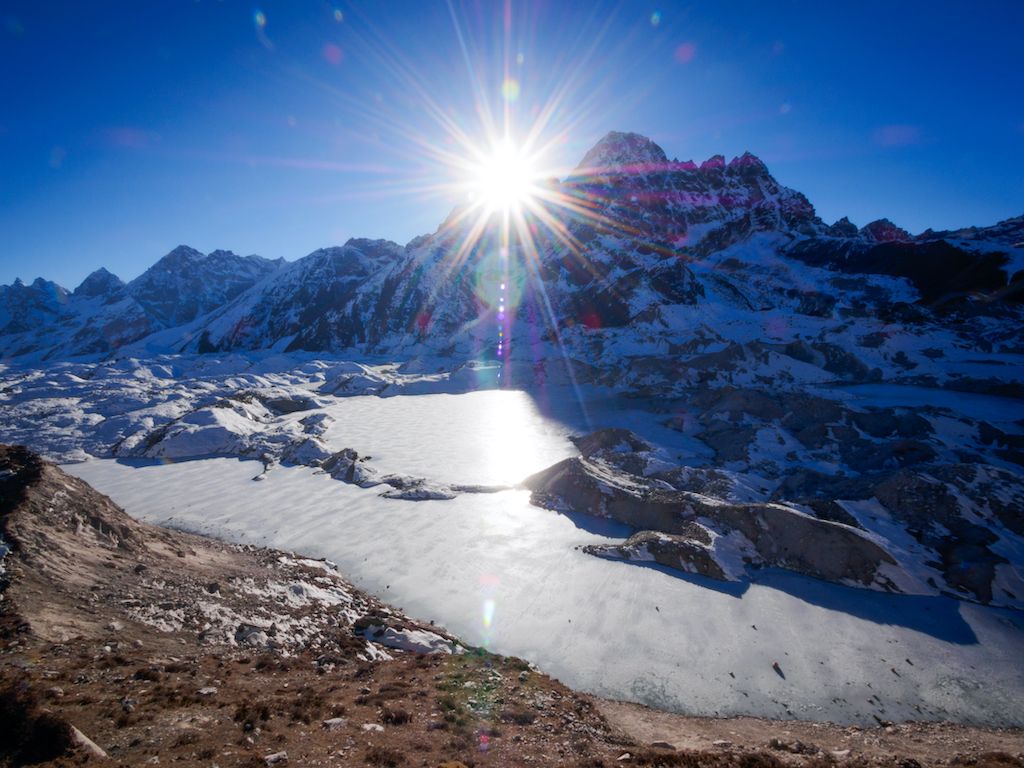Mount Everest At Risk: Climate Change Causing Himalayas Glacier Melting
5 Mins Read
By: T. V. Padma
India’s first regional climate change assessment warns of accelerated glacier melt.
Climate change has hastened glacial melting across the Hindu Kush Himalaya region, home to some of the world’s tallest peaks, including Mount Everest. According to India’s first assessment of climate change, the country’s glaciers—and water resources—will be at further risk without local actions.
The Hindu Kush Himalayas (HKH) are a 3,500-square-kilometer stretch of mountains that span eight countries. The region is called the “Third Pole,” as it contains the largest reserve of freshwater outside the polar regions. Its glaciers feed 10 large Asian rivers, including the Ganges, Mekong, and Yangtze.

Air over HKH warmed at a rate of 0.2℃ each decade from 1951 to 2014 and at the even higher rate of 0.5℃ per decade at elevations higher than 4,000 meters, according to the report, prepared by the Ministry of Earth Sciences (MOES) and released in June. The assessment explained that several areas, with the exception of the high-elevation Karakoram Himalayas, saw declining snowfall and retreating glaciers during the past half century.
The report projected that even with the Indian government’s commitment to mitigate greenhouse gases by 2030, the Indian Himalayas could warm by 2.6℃–4.6℃ by 2100. In the worst-case scenario considered by the report (Representative Concentration Pathway 8.5), the mean surface temperature over the whole region could rise by 5.2℃ by 2100.
By the end of the 21st century, the average temperature over the whole of India is projected to rise by approximately 4.4℃ compared with the 1976–2005 average, according to the report. Other impacts of this temperature change could include increased frequency of heat waves and more severe droughts, very severe cyclonic storms, and floods in Himalayan river basins.
Regional details on climate changes are needed to frame suitable policy decisions to estimate impacts on agriculture, water resources, power, and health.
Many Intergovernmental Panel on Climate Change (IPCC) reports “give a global perspective, but not many details are available on regional changes,” including those for India, said MOES Secretary Madhavan Rajeevan. When calculating data about monsoon rains, for example, Indian scientists have reported that regional climate models might even contradict the global models used by the IPCC.
“Unless we know more on regional details, it would be difficult to frame suitable policy decisions,” Rajeevan said. Such policy decisions may include estimating climate impacts on agriculture, water resources, electricity and power generation, and human and environmental health.
Threats to Water Security
Phenomena associated with retreating glaciers threaten regional water security. Dark debris cover, for example, absorbs solar radiation rather than deflecting it and therefore often increases a glacier’s rate of retreat. In a recent study on the state of more than 250 glaciers in the Suru River basin in northern India, scientists found an increase in debris cover of almost 62% from 1971 to 2017.
Retreating glaciers contribute to the formation of glacial lakes when glacial meltwaters and debris such as dirt and rock accumulate in mountain depressions. The first inventory of glacial lakes in HKH, prepared by the International Centre for Integrated Mountain Development (ICIMOD), reported 25,614 glacial lakes in the region.
More lakes could mean more frequent glacial lake outburst floods (GLOFs). Such events wreak destruction on small settlements and other infrastructure such as dams and hydropower plants downstream. Umesh Haritashya, an associate professor of geology at the University of Dayton in Ohio, and his colleagues recently analyzed a small GLOF caused by a surge in the Shispare Glacier in Pakistan that damaged a major highway, for instance.
Water security in HKH is also threatened by increased demand associated with improved socioeconomic conditions in the downstream region. An estimated 2 billion people depend on glaciers in HKH to supply water for drinking, irrigation, and energy. A recent assessment by ICIMOD showed that the gap in water demand versus what is actually supplied in eight surveyed towns in the Himalayas is between 20% and 70%, and the gap could double by 2050. “This could be a major cause for concern,” said Haritashya.
Mitigating the Impact of Melting Glaciers
Joerg Schaefer, a climate geochemist at Columbia University’s Lamont-Doherty Earth Observatory, said the new MOES report contains a comprehensive review of temperatures and precipitation changes in HKH.
“The carefulness and breadth of the compilation [are] exceptional. But the time frame to analyze glaciers’ response to climate change is too short to arrive at definite conclusions,” Schaefer said, adding that “it is difficult to rescue a glacier that has shrunk in size, as the main driver for glacier shrinkage is rising temperature. One can only mitigate the impact of the glacier melt and prepare at the societal and economic level.”
India’s Ministry of Environment, Forest and Climate Change is mandated to prescribe policy for the country’s response to climate change. The MOES report can “support and provide all data required” to the environment ministry, Rajeevan said, but cannot dictate policy response. Even so, it is clear, Rajeevan said, that India needs to reduce its greenhouse gas emissions and “move on to renewable energy sources like wind, solar, and ocean waves,” in addition to improving forest cover and other means to absorb the country’s carbon dioxide emissions.
Currently, India is committed to reducing its emissions intensity (annual greenhouse gas emissions per unit gross domestic product) by up to 35% from 2005 levels.

This story originally appeared in AGU’s Eos Magazine and is republished here as part of Covering Climate Now, a global journalistic collaboration to strengthen coverage of the climate story.
Lead image courtesy of Whitworth Images / Getty Images.




